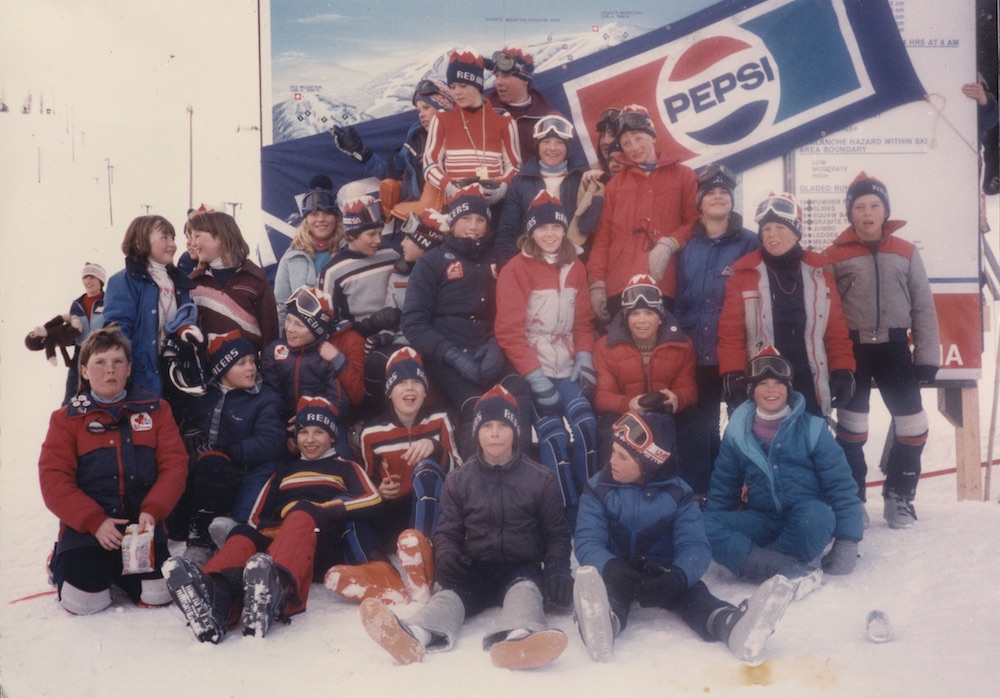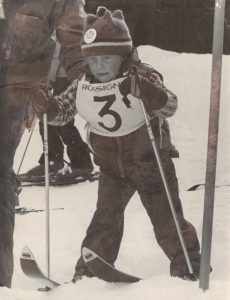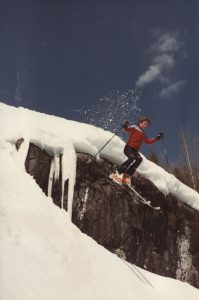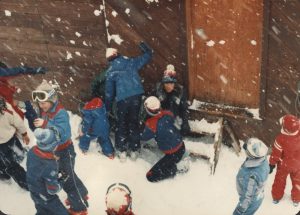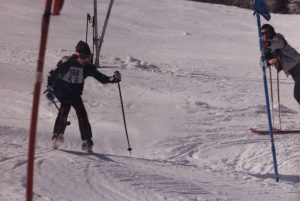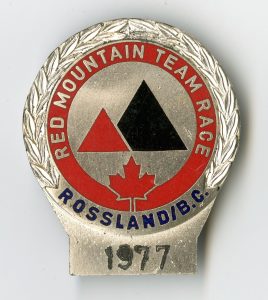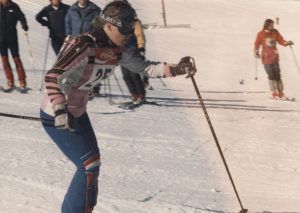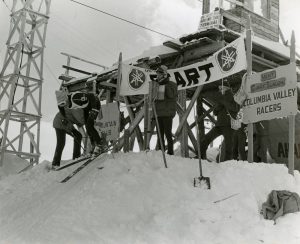Ski Programs for All Ages!
The Red Mountain Racers (RMR), as we know it today, started to take form in the 1970s. Volunteers created dedicated youth programs to give children of all ages access to quality coaching. Simultaneously, the competitive program began to expand.
Nancy Greene Ski League
Many Red Mountain Ski Club (RMSC) volunteers started a chapter of the Nancy Greene Ski League in 1969. This national ski program was named after Olympic gold medalist Nancy Greene (now Nancy Greene Raine). Nancy Greene Raine and Al Raine created the Nancy Greene Ski League with the Canadian Ski Association (now Alpine Canada Alpin) to introduce young skiers to racing in a team format. Greene Raine believed that “children’s competition [should] promote participation and fun and de-emphasize winning.” Following that belief, individual ski clubs across Canada developed and ran their own chapter of the League. They made local modifications as they felt necessary. For RMSC, the Nancy Greene League consisted of two non-competitive races on Sunday mornings for children ages 5 to 14. In later years, Libby Martin, a RMSC member and ski school instructor, added a training element to the program by offering ski school classes on Saturdays for the youngsters.
Talent Squad/Bantam League
In 1974, Mike Delich, a former Red Mountain racer, created the Talent Squad (later known as the Bantam League) for children ages 9 to 12. Bill Stevens and Jim Haight supported it. The program focused on developing children’s athleticism and ski racing skills while fostering their enjoyment of the sport. The children started training in the fall with dryland training, which involved conditioning classes, mountain trail running, hiking, and cross-country skiing. Once the ski season started, the youngsters trained on all terrain, including tree skiing, jumping, and groomed trails. Delich and other volunteer coaches also taught them the fundamentals of downhill and speed racing skills. They utilized Wednesday night skiing on the T-bar at Red Mountain to provide children with more gate training opportunities. The youngsters also competed in one or two ski competitions a year. These tournaments were hosted at Red Mountain as well as other ski hills around British Columbia.
The goals of the Talent Squad were simple; support individual’s determination and allowing young athletes to achieve personal bests, to have a special podium day and most importantly, after the camaraderie of their Talent Squad years, to lead a worthy and fulfilling [life] and career as an elite Olympic or National Team ski racer, businessman, educator, professional, or as parents enjoying [a] life-time sport with their own next generation ski families.
– Mike Delich, April 2022
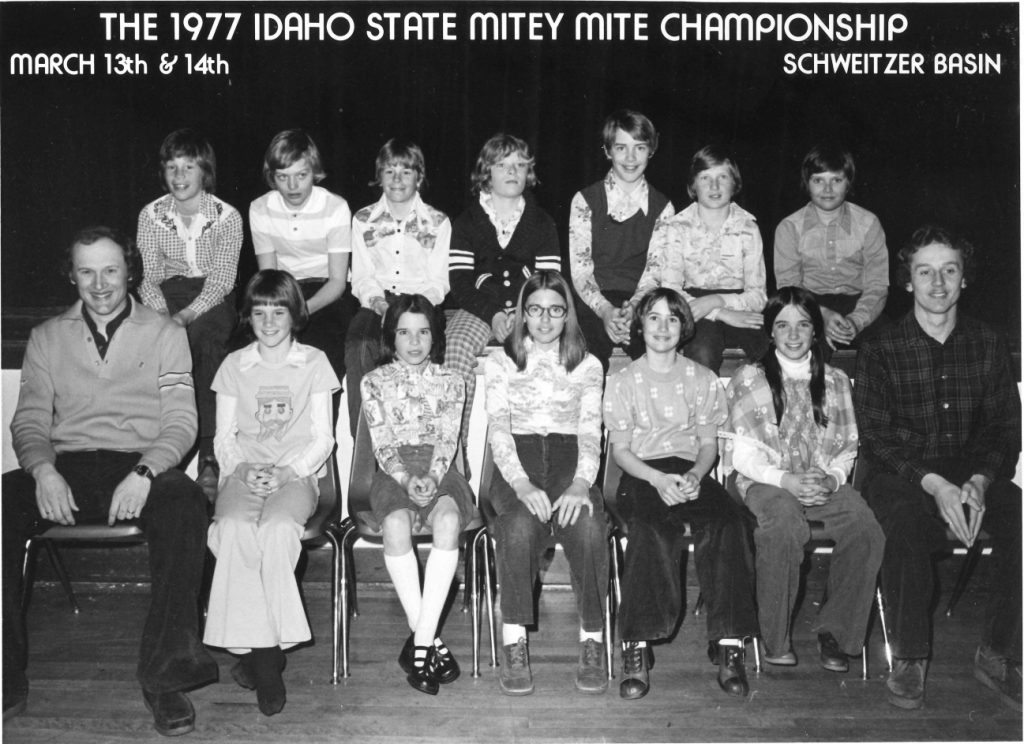
Mike Delich (front row, far left) with the members of the 1977 Talent Squad team in Sandpoint, Idaho (USA). L-R Front: Mike Delich (Director), Kerrin Lee, Cathy Demore, Michelle Daoust, Cheryl Ackroyd, Barb Wilson, Warren Wright (coach). L-R Back Row: Rob Bosinger, Bob Hubert, Peter Bosinger, Kurt Merrifield, Hans Trinkl, Steve Hanson, Dan Merrifield. Photo from Mike Delich, used with permission.
Cardholder/International Ski Federation skiers
As volunteers created the new ski classes, the competitive program for senior skiers, also known as cardholders or International Ski Federation (FIS) skiers, underwent many changes. After Ches Edwards retired in 1957, coaching continued in a volunteer capacity by several former ski racers who excelled internationally. These individuals included George Merry, John Platt, Bill Stevens, Verne Anderson, and many more. Despite the lack of a formal coaching program through the 1960s, their knowledge – including ski techniques learned in Europe – helped the next generation of racers grow. They ensured that the youth continued to gain racing experience, including introducing them to the importance of conditioning, holding race clinics for juniors, and setting race courses for competitions.
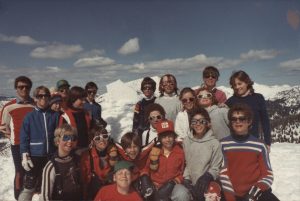
Red Mountain Racers at the top of Granite Mountain,1984. Lindsay Roberts, Hamish Martin (Blue left), Sean Valentine (grey front row)
By the 1970s, informal and voluntary coaching started to change. In April 1971, the RMSC created a race committee that took on the primary responsibilities of the racing program. This new committee formalized many of the same expectations the volunteer coaches had already established. For example, they aimed to introduce youngsters to ski racing techniques and the associated disciplines (dryland training, etc.). Additionally, they continued to operate ski classes for cardholders based on A, B, C, and D structures outlined by the Canadian Amateur Ski Association (CASA) and FIS. They started to formally hire coaches again and pay them what they were worth. As such, the program started to solidify and expand. In the first year, the committee hired Douglas “Butch” Boutry, a former Red Mountain racer. By 1978, they had to hire two full-time coaches, Grant Rutherglen (another former Red Mountain racer), and Pat Daly, to handle the number of racers.
Locals share memories of their coaches (captions available in both EN and FR). View this video with a transcript (EN).
Overall, these three programs created the Red Mountain Racers. The society known as the “Red Mountain Racers” officially formed in 1984. However, the racers, parents, and coaches commonly used the name as early as the 1960s. There was a brief period between 1972 and 1976 when the team was known as the Columbia Valley Racers because there were two skiers from Fruitvale and Nelson.


